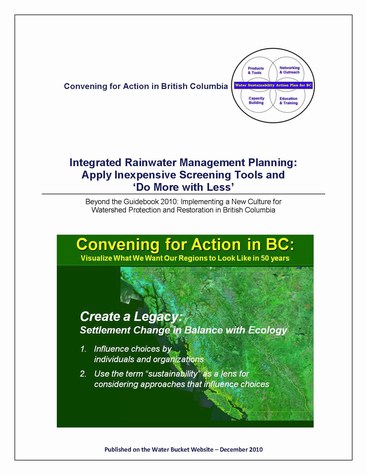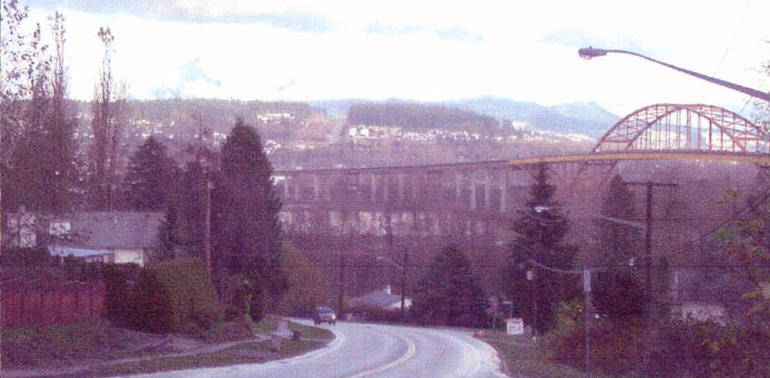Story #5 in the ISMP Course Correction Series: Apply Inexpensive Screening Tools and 'Do More with Less'
Note to Readers:
This article is an extract from the final installment in a 5-part series that is designed to inform local governments and others about the paradigm-shift to landscape-based ‘RAINwater’ from pipe-and-convey ‘STORMwater’, and what this means for Integrated Stormwater Management Plans (ISMPs).
- This instalment is built around City of Surrey case study experience. Now in its fifth decade of continuous implementation experience, the City continues to evolve and adapt a watershed-based approach that incorporates lessons learned in getting green infrastructure right.
- It opens with reflections on ‘what we have learned after a decade’ of ISMP experience; and closes with a reminder as to why local governments originally committed to an ISMP journey.
To download a PDF version of the complete Story #5, click on Integrated Rainwater Management Planning: Apply Inexpensive Screening Tools and ‘Do More with Less’
Shared Responsibility Context for Implementing ‘ISMP Course Correction’
The notion of ‘shared responsibility’ is a foundation piece for collaboration, alignment and integration. When these are in place, innovation will follow. Shared responsibility is a unifying theme for two case studies described in Story #5 in the ISMP Course Correction Series. The case studies illustrate the value of looking outside the pipe.
What We Have Learned After a Decade
A decade ago, local governments were venturing into uncharted waters when undertaking ISMPs. The experience of the City of Surrey and other pioneer leaders serves as a guide for the ISMP Course Correction.
An increasing local government infrastructure deficit now means that there will be even more competition for available funding. Thus, a driver for the ‘course correction’ is to demonstrate how to ‘do more with less’ by placing emphasis on what really matters.
This objective can be achieved through a front-end effort that connects with the community and gets the watershed vision right. Then create a blueprint to implement green infrastructure that truly restores the urban fabric. Recognize that implementation will be a multi-decade commitment.
When the use of screening tools is coupled with the front-end effort to create a Watershed Vision, this stretches a local government dollar further.
How to Achieve a Watershed Vision
If an ISMP is balanced and holistic, it is a potentially powerful tool because it does enable a local government to address HOW to achieve a watershed vision. If founded on the principle of collaboration, the ISMP process can achieve integration of perspectives. The ISMP process will then influence the land use and development processes that drive the look-and-feel of the watershed landscape.
 “Each ISMP area is unique and must be approached from the perspective of what is required in that watershed,” emphasizes Carrie Baron, the CIty’s Drainage & Environment Manager. “So the key message is that there is no one way for ISMP/watershed approaches; rather, it is a matter of looking at what is needed in each watershed and community, and then basing the approach on those needs.”
“Each ISMP area is unique and must be approached from the perspective of what is required in that watershed,” emphasizes Carrie Baron, the CIty’s Drainage & Environment Manager. “So the key message is that there is no one way for ISMP/watershed approaches; rather, it is a matter of looking at what is needed in each watershed and community, and then basing the approach on those needs.”
Bon Accord West: Case Study for a Level-of-Service Approach to System Upgrading
Story #4 introduced the Level-of-Service (LOS) approach in the context of ‘Sustainable Service Delivery’. Many local governments face the following type of situation: an existing system, some problem areas, and limited funding available for system upgrades.
Uniform Area Discharge Rate
Story #5 presents the City of Surrey’s Bon Accord West experience to illustrate application of an ‘LOS approach’ to an existing drainage system. This case study tested a uniform area discharge rate approach to drainage and flood prevention; and developed a cost comparison to demonstrate the the benefits of a pragmatic approach that strives to ‘do more with less’.
A lesson learned from this case study was that a uniform area discharge rate approach is an inexpensive way to provide relevant information for capital planning. It does this without the need for detailed and expensive computer simulation of the drainage system.
“By doing key infrastructure upgrades based on this approach, we determined that the City could achieve better levels of service quickly in Bon Accord West, and then look at upgrading other components on a normal asset renewal basis,” states Carrie Baron.
To Learn More:
Local government experience in Metro Vancouver and on Vancouver Island has informed the ‘ISMP course correction’ described in Beyond the Guidebook 2010: Implementing a New Culture for Watershed Protection and Restoration in British Columbia. Readers are encouraged to:
- Download and read the complete Story #5 by clicking on this link to Integrated Rainwater Management Planning: Apply Inexpensive Screening Tools and ‘Do More with Less’
- Access the other stories in ‘ISMP Course Correction Series’ by clicking on Water Bucket publishes excerpts from “Beyond the Guidebook 2010” about why and how to re-focus ISMPs on outcomes — Outcome-oriented planning is a problem-solving PROCESS. It is not a procedure. It is not a matter of applying a regulation or a checklist. Participants have to be committed to the outcome.

Posted December 2010



